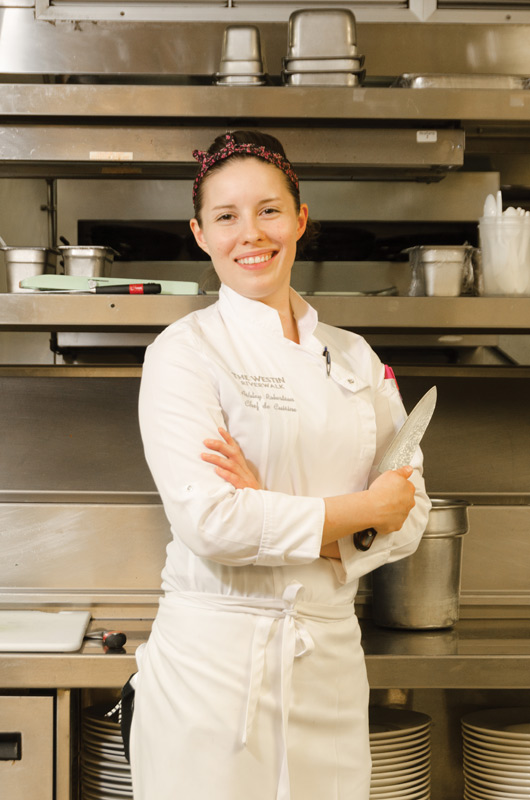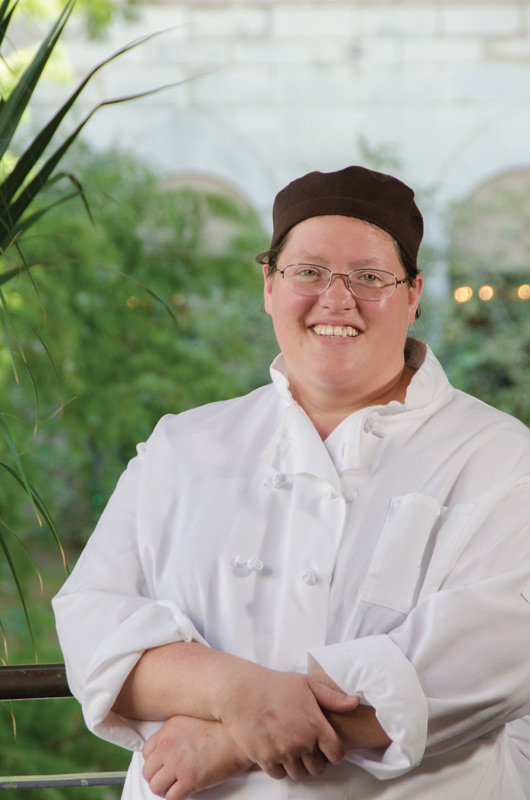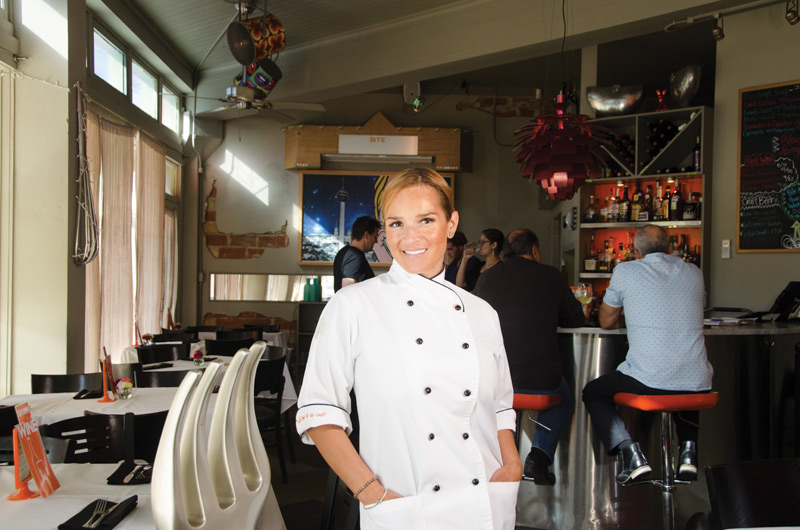IT’S NOT GLAMOROUS AND THE HOURS ARE LONG,
BUT WOMEN CHEFS LOVE THEIR WORK
By JASMINA WELLINGHOFF
PHOTOGRAPHY BY BRYAN LE NGUYEN
Women have been masters of the kitchen at home for a millennium, but relatively few have ventured into professional cooking, and even fewer are chefs in charge of busy restaurant operations. For this article we talked to two women who serve as
chefs de cuisine and one who is a pastry chef at a prominent establishment to find out about the joys and challenges of feeding hundreds of customers every week.
It Makes Her Happy
Located along a quiet stretch of the River Walk, Zocca Cuisine d’Italia in the Westin Hotel is one of the most attractive eateries on our famed waterway. With a spacious layout that allows privacy for each table, a nice patio, and lots of natural light flooding the interior, it’s the kind of place that says “come in, relax, enjoy yourself.”
And people do, including this writer, who recently experienced the establishment’s hospitality during a leisurely lunch with Zocca’s enthusiastic promoter, Michele Krier. We sampled an array of dishes, from hors d’oeuvres to desserts, all as tasty as they were good-looking.
Presiding over Zocca’s culinary operation since January of this year is chef Ashley Robertson, a friendly and passionate 27-year-old who oversees a kitchen staff of 22, many of them older than herself. A day or two after Krier and I enjoyed the fruits of her labor, I met Robertson for coffee and conversation during the relatively peaceful hour-and-a-half between breakfast and lunch.
“At first I was a bit intimidated,” admits the young chef. “Oh, man, there’s so much to do every day! But I feel comfortable now. It’s fun. I may start at 8 in the morning and leave at 10 p.m., but my day goes so fast. There’s so much to do that at the end of the day it doesn’t feel like I have been here so long. This job is challenging but never boring. You meet so many people every day, and you work with so many people. And it’s gratifying to know that we can cook something that somebody will enjoy, that I can make somebody’s day with my food.”
Zocca’s cuisine is basically Northern Italian, she explains, mixed with some local flavors and her own “viewpoint.” In addition to classic Italian pastas, her signature dishes include black-garlic salmon, lamb chops with strawberry demi-glace, and sea scallops with fennel and apple slaw and cranberry chutney. The menu also features a mouth-watering selection of appetizers as well as beef, pork and chicken entrees. Developing recipes is the fun part of the job, like playing with food, she says, and the best part is getting feedback from testers and eventually customers.
But her duties go well beyond “playing with food” to include planning for seasonal changes, ordering supplies, daily inventory surveys, mentoring and overseeing the staff, hiring new people and managing the entire kitchen budget and operation. Zocca feeds 220-230 people for dinner during the peak periods in the fall and spring. There are nights when the entire dining room is full of hungry expectations that she and her staff must respond to. “Those are the moments I like best, when we get hit with a flood of tickets (orders) all at once. I feel the thrill of it when everything works like a well-oiled machine — cooks cook, servers run back and forth delivering the goodies, and everyone is in sync. It’s wonderful,” she says.
Growing up in Denver, Robertson had little interest in cooking until at 15 she visited her grandfather who was a restaurant chef. Recruited to help around the eatery, she eventually got involved with the catering side of the business, and thoughts of going to culinary school started popping into her mind. The budding cook eventually received an associate degree in culinary and catering management from the Emily Griffith Technical College in 2007 and followed that up with a BS in hospitality management from the Metropolitan State University of Denver. After starting her career as a line cook at a Hyatt Regency Hotel in her hometown, the young woman progressed rather quickly to lead cook and kitchen supervisor at other hotels before moving to San Antonio when her husband, Ray Silvia, became a chef at the Hyatt Hill Country Resort here. Neither husband nor wife do much cooking at home.
Asked why more women are not found among chefs, Robertson speculates that stress and the work environment may not suit a lot of women. “Working as a line cook you get sweaty and dirty; it’s hard work, often grungy in a crazy environment. It’s not glamorous. You are not going to look good,” she notes. “So, many women may not like that, though I don’t mind.”
After pausing to consider the question further, she adds that another reason women drop out is that it’s almost impossible to have children and work as many hours as she does. That’s not an issue for her, however. “My career is my priority; it makes me happy,” she states matter-of-factly.
Another part of the job she doesn’t mind is the odd requests from patrons. “People ask for all kinds of things,” she says with a chuckle. “The new fad is gluten-free. It used to be whole wheat. People would say ‘I only eat whole wheat pasta.’ I am happy to change the dish for them. One person produced a long list of things she was allergic to. We accommodated her too. Sometimes they come in knowing this is an Italian restaurant and ask for nachos; others want to know where our salmon comes from.”
Then there are those who love the food so much they want to talk to the chef about it. Robertson obliges them, too. “When someone is so delighted by something you created, it gives you a great warm tingly feeling inside. It makes me forget that I have been on my feet all day,” she says.
The Domain of the Sweets
It’s not always easy to find really good nonstandard desserts at San Antonio restaurants, but Biga on the Banks is an exception. The River Walk restaurant owned by celebrated chef Bruce Auden offers a delicious selection of treats with names such as Grand Marnier souffle, almond chocolate joy, and chocolate rum mousse. How could you not be tempted to taste them?
The person responsible for the creation of most of these delicacies is pastry chef Amy Delbridge, who has been at Biga for 16 years. She started as a pastry cook, progressed to sous-chef and four years later became a co-chef with another woman. In February of this year, Delbridge became the sole mistress of the famed restaurant’s sweet domain. In addition to desserts, her team also bakes all the breads served in house on a daily basis.
“We make two types of yeast bread and cornbread,” she tells me as we are sitting in the handsomely appointed dining room early in the day, hours before the official opening time. “For our sourdough bread we are still maintaining the culture that was given to us by a former chef who started it 30 years ago. We have five other cultures that have been going on for 15 years. (A certain amount of each bread starter, or culture, is always used for the next round of baking.) The latter five are made with wild yeast from grapes, and the bread is allowed to grow slowly overnight in the refrigerator. The wild yeast culture gives the bread a better flavor and texture than commercial yeast.”
She then explains that the word “biga” refers to a fermented bread starter widely used in Italy to bake a variety of the crusty, holey breads people like. The difference between a biga bread and the sourdough kind is mostly in the way the starter is made and used. For biga loaves, the starter is made fresh every time. For someone like me who has never made bread from scratch, these are illuminating bits of information.
To make all the goodies for a week her kitchen uses some 225 pounds of butter, 150 pounds of sugar, 1,440 eggs, 200 pounds of bread flour, 200 pounds of all-purpose flour and approximately 75 pounds of brown sugar. And that’s just the basics. During the busy fall season the demand usually goes up, especially when banquets become more frequent, and breads and desserts must be made for several hundred people in addition to dining room patrons. But that’s OK with Delbridge. Like Robertson, she thrives on action: “I am never just sitting down. I am always going, going. I like that.”
If a banquet is on the agenda, her day may start at 4 a.m., but otherwise she and her staff start at 8 and are done by 4 in the afternoon. Since Biga is open only for dinner, the bakers prepare everything that’s needed for the night, then go home. Which is another aspect of her job she likes. “The pastry chef has better hours than the cooks, and there’s less pressure,” notes Delbridge. “After I became a mother, I definitely did not want to work in the evening.”
Though both her mother and grandmother instilled in her a love for baking, she got to her present position more through serendipity than intent. When her parents retired from their military careers, the family settled in San Antonio, where Amy attended Holmes High School and later Palo Alto Community College. At some point, she needed a job, and it so happened that one was available at the former Espuma Café in the King William District. While there, the young woman got to make all sorts of things, including soups, quiches, salads and sandwiches. Five years into that job, a customer mentioned to her that he was leaving a management position in a well-known restaurant to work as a waiter at Biga, which was about to open. He was an admirer of Auden’s new American cuisine and excited about being part of the new venture. That got Delbridge thinking that maybe she, too, should apply for a job there. “So I did, and Bruce put me in the pastry department, which I loved right away,” she says. Though she has served in other capacities over the years, the domain of the sweets is still her happy place.
Unlike Robertson, Delbridge does cook at home because she has a 13-year-old daughter and wants to enjoy a family dinner with her. Her personal favorite desserts are the Italian cream cake and treats that remind her of her childhood, like grandma’s strawberry pie and strawberry jam. Both the cake and the pie made appearances on Biga’s menus in the past but are not currently offered.
When we ask her the same question we posed to Robertson about the paucity of women in leading culinary positions, she brings up some of the same issues about hard physical work and having children but also points out that, as mothers, women need health insurance benefits, which her employer does not provide at this time. Various attempts to solve that problem did not quite work out, she notes. Still, insurance or not, there are more women pastry chefs than executive chefs. Maybe they just prefer the nature of the work. No one has done a survey on these matters.
“Making desserts is more like science; you have to be more precise at every step,” says Delbridge. “If you miss one ingredient while making a cake, it’s junk and you have to start all over. I love that aspect of baking.”
Small but Special
Lisa Astorga Watel likes to do things on a small scale. Her Bite Restaurant on South Presa has only nine tables, and it specializes in “small plates.” Instead of three lamb chops you get one, instead of half a duck, you get a quarter, says the website, but the excellent ingredients and expert preparation guarantee a fine dining experience. Patrons seem to agree, as many online reviews sing the praises of various dishes such as the butter-poached lobster, octopus carpaccio, the lamb cigar (an appetizer) and the banana flambé dessert. Inventively presented cocktails also get high marks. Both the size of the place and the size of the meals allow her to be more creative and more responsive to individual customers, says Astorga, who is the chef-owner.
“I interact with customers all the time,” she points out enthusiastically. “They call me and ask, ‘What are you going to have tonight?’ and I tell them, ‘What would you like to have? I’ll make it.’ You can do that if you have a small place. And smaller dishes make it easier to experiment and incorporate new ingredients, so that, again, I can deliver a more personal experience to the customer.”
Though the Zagat review describes Bite as a “secret gem that furnishes clever, flavorful and filling French-Chilean plates,” the owner thinks of her menu as eclectic and always changing. “I have traveled a lot and I like to explore other flavors. I include something that will surprise people every day,” she explains. “We play with the menu and do fun foods.”
Due to its location, Bite caters primarily to dinner customers but offers increasingly popular brunch on both Saturday and Sunday. Diners come from all over the city, and without a reservation you may have to wait for quite some time. In addition, special monthly “wine dinners with a theme” have developed an enthusiastic following. On those occasions, a wine expert may talk about wine-and-food pairings, or the patrons may be entertained by circus artists. “Everybody is loving it,” says the dynamic chef.
Born and raised in Santiago, Chile, young Lisa loved helping her grandmother in the kitchen but, like Robertson, never thought of cooking as a career. Back then, it seemed to be the domain of men. Yet the more cooking she did, the more interested she became in a food-related career. Following graduation from high school, she moved to Houston to stay with relatives and eventually enrolled in the culinary program at Houston Art Institute. Then came an internship in Paris and travels to Norway, Denmark and Spain, where the newly minted pro explored different aspects of the food industry. In Norway, for instance, she learned all about the local lobster species that live in the cold waters of the Atlantic and the North Sea.
Back in the States, Astorga got a job cooking for actor Tommy Lee Jones’ family, an experience that lasted eight years – including cooking on movie sets — and generated fond memories. “Oh my God, it was fun,” she says with a broad smile. She traveled with the family and met a lot of their famous friends. It was also through Jones that Lisa met her husband, Damien Watel, a French native and long-time chef at the popular Chez Vatel Bistro on East Olmos Drive. Married in 2010, the couple have a 5-year-old son, Enzo, who often hangs out with Mom at the restaurant.
It was Damien who first suggested opening a dining establishment for her to run. Though hesitant at first, Astorga changed her mind when a friend showed her the present spot, then a Southtown beer joint. She credits Damien for visualizing and conceptualizing the new setup and helping her develop the menu. “He is not just my husband, he is also my mentor,” she acknowledges. Though each spouse has a professional kitchen in which to showcase his/her talent, on their nights off, the two often join forces to teach cooking classes for private parties under the business name “Cooking with the Watels.” And as if all of that was not demanding enough, the Watels enjoy entertaining in their home, too, mostly on Monday nights, when the restaurants are closed.
Before leaving the cozy eatery, I get to sample Astorga’s butter-poached lobster, which comes in a very deep plate, accompanied by crisp pieces of toast. It looks small, but it’s indeed delicious and satisfying, as all those online reviewers said. I make a mental note to return to check out a few other delicacies.
*For special recipes from our featured chefs, pick up a copy of SA Woman today!












0 Comments